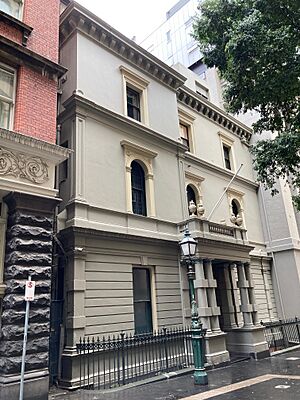Melbourne Savage Club facts for kids
 |
|
| Formation | 1894 |
|---|---|
| Founded at | Clubhouse occupied since 1923 |
| Purpose | The arts, science and law |
| Location | |
The Melbourne Savage Club is a private club in Australia. It was started in 1894. The club is named after a poet named Richard Savage. It was created for people who loved literature, arts, sports, or science. Members of the club are often leaders in arts, business, and politics. They keep their membership details private. Members can also visit other private clubs around the world through special agreements.
Contents
Club History and Purpose
The Melbourne Savage Club was founded in 1894. It was inspired by the London-based Savage Club. Both clubs were named after the English poet, Richard Savage. The first President of the Melbourne Savage Club was Dr. Harvey E. Astles.
Key Leaders and Mergers
Over the years, many important people have led the club. Sir Robert Menzies, who was a long-time Prime Minister of Australia, served as its President from 1947 to 1962. In 1966, the club joined with the Yorick Club. These two clubs had a friendly competition, even playing cricket matches together. More recently, Hubert T. Frederico was President from 1974 to 1977. Robert Heathcote was President in 2012, and Ian Baillieu was President in 2016.
Helping the Community
While the club's main goal is for members to enjoy themselves, it also helps others. For example, in 1929, two paintings by club member Napier Waller were given to a church in Geelong. The club also organizes social events to raise money for charities and patriotic causes.
The Club Building
The Melbourne Savage Club bought its own building in Bank Place, Melbourne in 1923. This building was first designed by A. L. Smith and A. E. Johnson. Later, Kingsley Henderson made some changes to it. Kingsley Henderson also designed other famous buildings in Melbourne.
Building Features
The club building is one of the few old townhouses left in the area. It shows a mix of old and new building styles from its time. It has special features like a front porch with unique columns. The windows on the first floor are also unusual. Inside, the dining room has special fans called punkahs that are powered by electricity to keep it cool. The main staircase and some fireplaces are also very old and interesting.
Famous Members
Many well-known Australians have been members of the Melbourne Savage Club. Here are a few:
- Ted Baillieu, a politician
- Senator George Brandis, a lawyer and politician
- Sir William Dargie, a famous portrait painter
- Sir Owen Dixon, a judge
- John Elliott, a businessman
- W. R. Guilfoyle, who started and managed Melbourne's Botanic Gardens
- Lindsay Bernard Hall, who directed the National Gallery of Victoria for many years
- Barry Humphries, a well-known comedian
- Sir John Longstaff, a painter
- David Low, a cartoonist
- Frederick McCubbin, a painter
- Sir Tom Roberts, another famous painter
- Sir Arthur Streeton, also a painter
- Alberto Zelman, a musician
Savage Clubs in Other Cities
Similar Savage Clubs were also started in other Australian cities:

